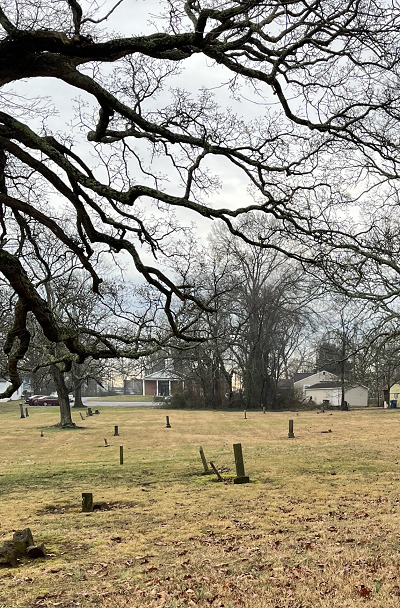
BY SHELLIE TAYLOR
Every February, the Iredell County Public Library staff joins the African-American community in celebrating the achievements of Black men and women in our county and promoting their stories during Black History Month.
 This year we are excited to be a part of the efforts to recognize a very special site in Statesville, the Green Street Cemetery. The oldest public African-American cemetery in Statesville, it is located at the end of Green Street on the corners of Green, Chambers and Elm streets.
This year we are excited to be a part of the efforts to recognize a very special site in Statesville, the Green Street Cemetery. The oldest public African-American cemetery in Statesville, it is located at the end of Green Street on the corners of Green, Chambers and Elm streets.
The earliest land deed was recorded December 17, 1885. The land was sold by Mary C. Bell to the trustees of the Colored Graveyard Association. No acreage was listed in the deed, but it is likely to have been about a half-acre. We suspect this because the current GIS map lists the cemetery today as comprising of 3.38 acres, and in 1888 an additional 2.75 acres were purchased from Bell by the trustees. The first tract of land was purchased for $150 by the association and the second tract was purchased at $200 paid by the City of Statesville. Today, the cemetery is still listed as being owned by the Colored Graveyard Association, although no such organization exists anymore. The site is maintained by the City of Statesville.
Prior to the creation of the cemetery, African-Americans in Statesville were being buried at local churches. Following the Civil War, three Presbyterian churches were established in Statesville by and for recently freed slaves. These churches were Freedom (near Bethany Church on Highway 21), Logan (in the Scotts community off Highway 64 heading toward Taylorsville), and Cameron (in the Elmwood community on Salisbury Highway heading toward Rowan County). Although all are within Statesville limits, the churches are on the outskirts of town. Green Street was an ideal location within an already established African-American community to bury the deceased.
 There were also two churches located near the cemetery. Emmaus Baptist Church, which would eventually become First Baptist, was established in 1874. It was located on Green Street on the same block as the cemetery. Scotts Chapel Methodist was established in 1885. It was located on Chambers Street, slightly south of its current location. First Baptist would erect a building on property adjoining the Black school which became Morningside, which was adjacent to the cemetery. Neither church had its own cemetery, so having a burial ground centrally placed in the neighborhood just made sense.
There were also two churches located near the cemetery. Emmaus Baptist Church, which would eventually become First Baptist, was established in 1874. It was located on Green Street on the same block as the cemetery. Scotts Chapel Methodist was established in 1885. It was located on Chambers Street, slightly south of its current location. First Baptist would erect a building on property adjoining the Black school which became Morningside, which was adjacent to the cemetery. Neither church had its own cemetery, so having a burial ground centrally placed in the neighborhood just made sense.
The earliest documentation we have of the cemetery is from 1886. The Genealogical Society of Iredell County has in its collection an original document with the name “Union Grove Cemetery” on it. Two plots were purchased by H.J.C. Chambers and paid to R.D. Bailey. Chambers was not after his death in 1892, but the 1886 document proves that orders were being taken and that the cemetery was already being used. There are several different names used to refer to the Green Street Cemetery. The most common was “Union Grove Cemetery.” As early as 1907, the Union Grove Cemetery is listed in the Statesville City Directory. However, this name does not appear on death certificates as a burial location until much later, typically in the 1930s and 1940s. It is unknown why this name was used. Most Iredell residents hear Union Grove and appropriately think of the township in the far north of the county which borders Yadkin County. It is possible that this section of Statesville was inhabited by many former Union Grove residents. After the Civil War, former slaves looking for paying work migrated to towns and cities to look for jobs. This theory has never been proven, but it is a possibility.
Many of the early burials at this site were of people who had been born into slavery and were of the first generation of free African-Americans in Statesville, making the cemetery historically significant. About 25 percent of those buried here were born prior to 1865. The cemetery closed indefinitely in 1949 due to deterioration of the site and because it was filling up. The Belmont Cemetery on Greenbriar Road opened in 1943 and is still in use today.
The library recently obtained a $20,000 grant from the North Carolina Humanities Council to fund a ground-penetrating radar survey and to erect memorials at the historic site. The goal of this project is to identify the burial locations of unmarked graves to help get a more accurate count, and also to locate evidence of any structures that once stood on the site. This would help in determining the purpose of the property prior to it becoming a cemetery. About one-third of the grant funds will be used for the GPR survey and the rest of the funds will be used for memorials for unmarked graves and educational signage.
This amazing project has been a partnership with Iredell County, the City of Statesville, and the Statesville chapter of the NAACP. The NAACP chapter has conducted cleaning of the cemetery in the past and plans to do so again following the GPR survey and installation of the memorials.
On January 30, City of Statesville crews cleared some of the brush behind what used to be an annex to the Morningside School and the Davis and Magnum Funeral Home. There were three graves behind the building that library staff were made aware of over the summer. An additional six stones were discovered during the clearing, and we hope that by making a path for the GPR equipment, we might be able to locate unmarked graves as well.
The library will be hosting a program about the history of the Green Street Cemetery in honor of Black History Month. “Exploring the Green Street Cemetery” will take place at the Statesville Library on Tuesday, February 21, at 5:30 p.m. and Thursday, February 23, at 6 p.m. The library also has a display for Black History at the front entrance. The display will be available for viewing throughout the month of February.
Shellie Taylor is the Local History Program Specialist at the Iredell County Public Library. She can be contacted at michelle.taylor@co.iredell.nc.us or 704-878-3090, Ext. 8801.




I long to see the cemetery recognized as legitimate Iredell history. Hope this, along with other significant contributions along Garfield and Green Street, will become part of the historic district of Statesville. Thank you for your beginning work.
First, I want to say thank you for addressing this historic cemetery and your recognition of this historical significance in your well read by the public publication. Second – I do want to bring to your attention and the attention of your readers how necessary it is that we also look at how our vocabulary can bring about change. It is so unnecessary to use a vocabulary that was so wrongly acceptable 100 years ago. In 2023 we know that it’s more accurate to say that people were survivors of enslavement laws and that the majority of Black people here served in slave labor. We must first recognize those ancestors as people and then the circumstances of all American people. Thank you. Lisa Mozer
A very special thank you to everyone.involved in this project. My hope is that a wall, something like the Vietnam Wall, or another way to list everyone’s name who is buried there. I believe this will be a great historical attraction for the City of Statesville. I would love to see my grandparents, aunts and uncle’s names listed. Shellie Taylor and others, thank you again for helping Dr. Lisa Mozer, me and other African Americans’ dream come true.
Vivian Williams